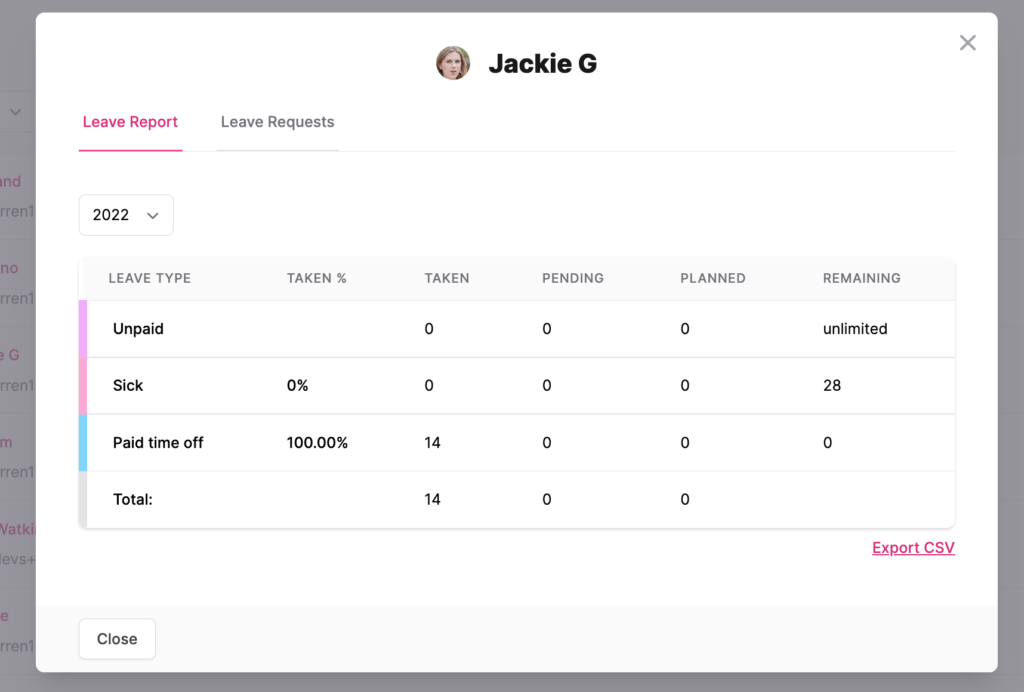April 16, 2024
HR Teams and Managers’ Guide to Leave Planning
An efficient leave planning process is vital if you want to allow your employees to take time off without cau...

There are a lot of moving parts involved with running a business. With things like product design, project management, sales, marketing and custom support taking up headspace, HR tasks like leave management may be an afterthought.
But if you want to run a high-performing team, your leave management process is vital. You need an efficient system down to handle time off requests, and make sure there’s an easy flow of information between all relevant areas of the business whenever someone asks for time off.
Read on to learn all you need to know for your company’s leave management system.
Further Reading: Leave Management System Best Practices, Software Tools, and More
So what is leave management exactly?
Leave management is the process your company follows for managing time off in your business – such as paid vacation or medical leave.
Employee leave management spans everything you do in this process. From developing policies, communicating policies to employees, to what happens when someone submits a time off request.
This is a Human Resources (HR) task, and in mid to large sized organizations, there’s generally an HR department to handle leave management processes.
However, many modern companies and newer startups operate on a leaner basis, and don’t have a dedicated HR team. That means it’s up to department heads, or in some cases the CEO of the company.
For these companies, it’s important that everyone knows what their responsibilities are in terms of leave management, to ensure that the needs of the employees (in regards to paid time off) are not forgotten.
“Leave management” can be quite a broad – and vague – term. So let’s make it a little clearer, and look at a few of the actual tasks that make up the leave management process.
The first step happens before someone makes a time off request. It’s the policies that let employees know what’s allowed and what’s expected of them in regards to paid time off, along with how the rest of the leave management process should work.
Further Reading: How to Create Your Employee Leave Policy
Time off requests are the key part of the leave management process – such as how and where people ask for time off, and any rules regarding time off requests.
What happens when someone asks for time off? Who reviews these requests, and what do they do to decide whether to approve or deny a request? What happens in regards to notifying employees about the status of their request?
When a time off request is approved, it needs to go on a schedule, to make sure no one’s surprised when the employee doesn’t show up for work one day.
Similar to the previous task, any relevant information about the leave needs to be passed on. This could mean notifying the project leader that one of their team members will be on leave, or passing information to payroll.
Finally, leave management also includes how you track leave requests and any related trends. This can mean looking for absenteeism (abnormally high absence rates), or presenteeism, which is the opposite.
We usually only consider absenteeism a problem, but the opposite is also an issue. If an employee doesn’t take enough time off, their productivity is likely to drop in time, and they may be at risk of burnout.
Learn More: all you need to know about Employee Burnout, and how to prevent it.
Let’s now look at a few reasons why it’s worth the time and effort to build a robust leave management system.
The biggest issue with leave management for most teams is how time-consuming it is. You’ll find this out if you’re a solo founder of a small startup, and have to manage this yourself. Many founders end up spending so much time on unproductive HR tasks like this, that they have barely any time or energy left to overlook the high-leverage parts of the business.
A good leave management system will save time, and free up resources for other areas of the business.
Effective leave management means no confusion, no disruption when team members take time off. This means higher overall productivity from the team as a whole.
A good leave management process makes it easy (and provides little disruption to productivity) for employees to get rest, and recharge.
This is going to lead to a more high-performing team in time, with less cases of employee absenteeism or burnout.
When it’s easy to take time off, employees are happy. In contrast, an overly complicated leave management system makes employees exasperated and stressed, and has a profound negative effect on the satisfaction of your team.
95% of employees rate paid vacation as a very important part of their working arrangement. Make it easy for them to take it.

Want your leave management system to be as efficient and effective as possible? Feel like your current system is taking too much time, and proving too difficult for your employees to navigate?
These tips will help.
First, try to find simplicity at every step (without cutting corners, of course).
Make sure your leave policy is simple and easy to read. Streamline the leave request and approval workflow, and make it simple to look up your vacation calendar or check on leave balances.
This will reduce stress for both the HR department and employees, and end up saving a lot of time.
Leave management can be open to questions of bias or unfairness. Make sure everything about the process, but in particular, the guidelines for approving or denying leave requests is transparent, and fair.
Don’t obfuscate the decision making process or how the HR team manages time off.
As mentioned before, your guidelines – such as your time off request policy, and leave policy – should be simple and clear.
They should also be easily accessible to employees. If someone wants to find out how many days’ sick leave they have, or what they need to do to request parental leave, it should be easy. Don’t make people jump through hoops.
It’s important to know your legal responsibilities, as per federal and state laws, and make sure your leave management system complies with these.
This may mean a minimum number of days off for employees, or certain public holidays you need to observe.
It’s worth mentioning that the average number of PTO days offered to employees, particularly in the US, is frighteningly low. So are the legal requirements in most parts of the US. If you’re offering a reasonable amount of PTO to your employees, you’ll probably be over what the law requires.
However, make sure you consult a legal professional to be totally free from legal trouble.
Finally, it’s worth it to invest in a leave management software tool.
A software tool will take care of a lot of the small, menial data entry and busywork with leave management, saving you (or your team) a lot of time.
It makes it easy for employees, as well as managers or HR staff to check on and approve/deny leave requests, along with tracking trends.
If you’re one of the 12 million Slack users worldwide, Flamingo is the best tool for the job. It takes minutes to set up, and lets you manage the entire leave management system without leaving Slack.
There’s also advanced features such as an automated leave calendar, customizable leave reports, trends, and exportable data (helpful to maintain compliance and reduce payroll errors).


Flamingo is free to try. It remains free for life for small teams, while for larger teams, it’s a small and predictable monthly cost.
The money you spend on an automated leave management system will more than pay for itself in the time and stress you save by automating 90% of your time off management process.
Flamingo makes managing your team’s paid time off a breeze.